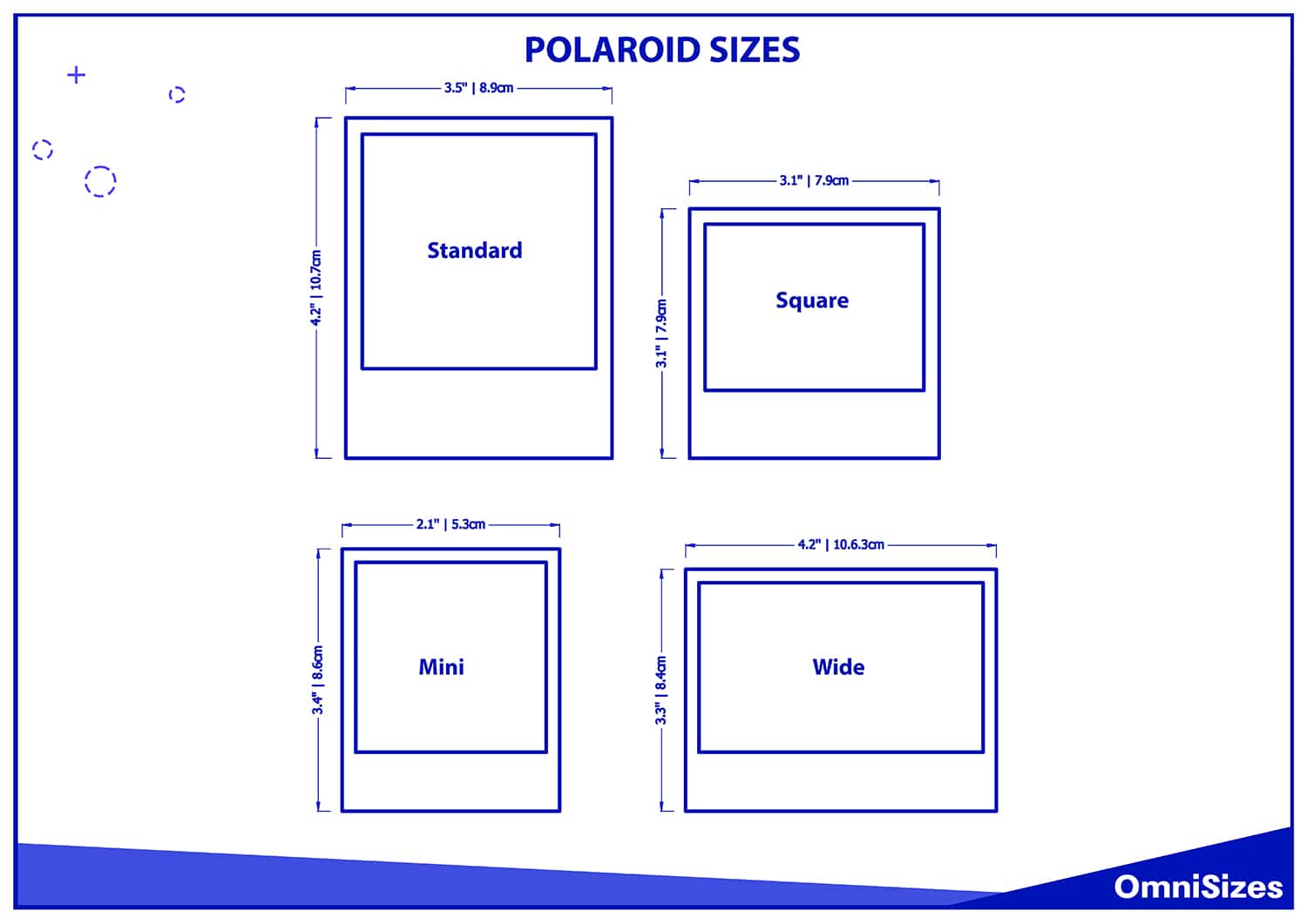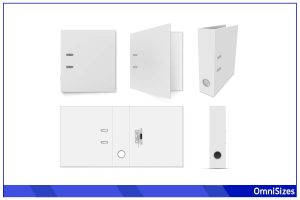Polaroid sizes have been a captivating aspect of photography ever since the Polaroid camera’s inception. Over the years, these sizes have evolved so photographers can immortalize precious moments in varying dimensions.
The standard Polaroid size is 3.5 × 4.2 inches (8.9 × 10.7 centimeters). However, there are several variations ranging from the classic square 3.1 × 3.1 inches to more expansive formats like the wide Polaroid (4.2 × 3.3 inches).
This guide will go into greater detail regarding common and not-so-common Polaroid sizes, as well as offer tips on how to store your instant photos the correct way.

Polaroids vs. Other Photo Formats
Photography has witnessed a plethora of formats. While Polaroids offer instant gratification with their on-the-spot prints, other formats have their merits.
Polaroids vs. Standard Photo Prints
Standard photo prints, typically produced from digital cameras or film, come in various sizes like 4 × 6 or 5 × 7 inches. These prints offer flexibility in editing and are often used in albums or frames. Polaroids, on the other hand, give a raw and unedited appeal.
Their spontaneous nature often captures the mood of the moment, making them cherished keepsakes. However, unlike standard prints, Polaroids don’t allow for post-shot editing.
Polaroids vs. Digital Photos: Aspect Ratios Explored
Digital photos dominate today’s world, thanks to smartphones and digital cameras. These images have different aspect ratios like 16:9 or 4:3, affecting the image’s dimensions. Polaroids have a more consistent aspect ratio, often resulting in square or near-square outputs. While digital photos provide the luxury of multiple shots and digital storage, Polaroids offer tangibility, creating a physical memory instantaneously.
Polaroids vs. Film Photography
Film photography, the precursor to digital, offers a depth and warmth that many enthusiasts swear by. Using negatives, film captures images that are then developed in a darkroom. This process can be time-consuming and requires skill. Polaroids simplify this by merging shooting and developing into one step. However, film photos can be enlarged without much quality loss, a challenge with some smaller Polaroid sizes.
Polaroids vs. Slides
Slides, often used for presentations or vintage projectors, are transparent photos that allow light to pass through, projecting the image onto a screen. They offer vibrant colors and are best for group viewings. Polaroids, being opaque prints, are more personal and best suited for close-up viewings. Their immediate output contrasts with the processing time slides often demand.
Standard Polaroid Sizes
Polaroid cameras, with their instant print capabilities, have provided enthusiasts with diverse size options for capturing memories. With time, the world has seen several standard sizes emerge.
3.1 × 3.1 Inches (The Classic Square)
The classic square, measuring 3.1 × 3.1 inches (7.9 × 7.9 centimeters), remains a favorite for many. This symmetrical format lends itself well to a variety of subjects. Whether it’s a serene landscape or a vibrant portrait, the square frame delivers a balanced composition that appeals to the eye.
3.5 × 4.2 Inches (Standard Polaroid)
Often recognized as the definitive size, 3.5 × 4.2 inches (8.9 × 10.7 centimeters) Polaroids strike a balance between dimension and detail. With enough space to fit subjects comfortably, this size is versatile and widely used. It’s an excellent choice for beginners looking to explore Polaroid photography.
Specialized Polaroid Sizes
While standard Polaroid sizes have dominated the scene for years, specialized sizes have also gained traction. These niche sizes provide a fresh perspective to those looking diversify their Polaroid collections.
Mini Polaroid: Convenient and Pocket-friendly
Measuring a petite 2.1 × 3.4 inches (5.3 × 8.6 centimeters), the Mini Polaroid is a hit among those on the move. Its compact size makes it easy to carry, fitting snugly into wallets or mini photo albums. While smaller, it doesn’t compromise on clarity, capturing sharp images that exude charm.
Wide Polaroid: Capturing Panoramic Vistas
For those keen on seizing more of the scene, the Wide Polaroid is the go-to. Spanning 4.2 × 3.3 inches (10.6 × 8.4 centimeters), it offers a broader view, making it ideal for landscapes, beach scenes, or bustling cityscapes. The width gives images a cinematic touch, setting them apart from regular shots.
Zoom Polaroid: For Detailed Close-Ups
Zoom Polaroids, though not a specific size, come with adjustable lenses that allow for detailed close-up shots. These Polaroids bring subjects into sharp focus, highlighting intricate details often missed by standard lenses. Ideal for nature shots, jewelry photography, or macro images, they showcase the finer points with precision.
How to Store and Display Different Polaroid Sizes
Different sizes offer various display possibilities. Here’s a guide to storing and showcasing your cherished Polaroid memories.
Preservation Tips for Longevity
- Keep Them Dry: Moisture can damage Polaroids, causing colors to fade. Store them in a dry place, away from dampness.
- Avoid Direct Sunlight: Prolonged exposure to sunlight can lead to discoloration. Find a shaded spot or use UV-protective frames.
- Use Acid-Free Albums: When storing in albums, opt for acid-free pages. This prevents the photos from yellowing over time.
Creative Display Ideas for Every Room
- Floating Shelves: Arrange your Polaroids on floating shelves. Different sizes can be staggered for a dynamic look.
- Polaroid Collage: Group your photos in a collage frame, mixing and matching sizes for an eclectic feel.
- String and Clips: Hang a string or fairy lights and use clips to attach your photos. It’s a flexible display, allowing easy additions or changes.
- Shadow Boxes: For a 3D effect, place Polaroids in shadow boxes with mementos from the same occasion.
Albums and Portfolios: Organized Collections
- Binder Albums: For those who have a vast collection, binder albums with plastic sleeves can be practical. They allow easy categorization by size or event.
- Accordion Albums: Ideal for mini Polaroids, accordion-style albums let you flip through memories swiftly.
Digital Displays: Merging Old with New
- Digital Frames: Convert your Polaroids to digital format and use digital frames. These frames can cycle through photos, giving each size its moment of glory.
- Polaroid Scans on Tablets: Scan your Polaroids and display them on tablets or digital devices, keeping the tactile feel alive in a modern format.






